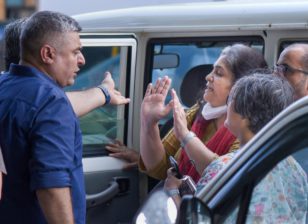Chandrayaan-2 goes up successfully, places satellite in orbit
It achieves an orbit 6,000 km more than what was targeted
India’s second lunar journey and its first-ever mission to be spearheaded by two women got a boost after the ambitious Chandrayaan-2 mission, headed to the moon’s South Pole, achieved an orbit 6,000 km more than what was targeted
The Indian Space Research Organisation (ISRO) put behind its last week setback and achieved a perfect launch at 2.43 p.m. from the second launch pad at Satish Dhawan Space Centre, SHAR, in what was the GSLV-MKIII’s first operational flight.
From the scientists at the Mission Control to those at the Viewing Gallery, the media centre, and millions watching on television across the nation, the launch seemed like a nail-biting sports match. The cheers, whistles and claps every time a launch objective was achieved, at the Viewing Gallery and the Media Centre, gave the launch a semblance of the reception normally given to film stars or excellent sportspersons.
Sixteen minutes after the rocket rose into the cloudy skies leaving a trail of bright orange plumes and its engines let out a majestic roar before vanishing behind the clouds, the spacecraft was injected into orbit at a perigee of 169.7km and apogee of 45,475 km, the apogee more than what was targeted.
“The GSLV-Mark III vehicle has successfully injected Chandrayaan-2 in the defined orbit. In fact, the orbit is 6,000 km more than what was intended. The satellite will have more life, more fuel and more time to play with the manoeuvres. It is the beginning of a historical journey of India towards Moon and to land at a place near the South Pole to carry out scientific experiments to explore unexplored [areas],” ISRO Chairman K. Sivan said from the Mission Control after the launch. In fact, the GSLV performed 15% better than the previous launch, he pointed out.
“Having injected the satellite in the intended orbit, whatever satellite team wanted to do tomorrow, the launch vehicle did it today,” he said. In the next one and a half months, the satellite team would undertake 15 ‘very crucial manoeuvres’.
Mr. Sivan lauded everyone associated with the project. He said the ‘serious technical snag’ that led to the abortion of the launch last week had been fixed and “now ISRO has bounced back with flying colours”. The snag was observed in an intelligent way and the work done in the following 24 hours was “mind- boggling”, and the vehicle brought back to normal quickly. A series of required tests were conducted in the next one and a half days and the vehicle was handed over to the team for launch.
Mr. Sivan complimented the satellite team for literally burning the midnight oil to get the satellite ready for launch.
The successful placing of the satellite in the Geosynchronous Transfer Orbit (GTO) was only the first step in a very complex operation. With ISRO tweaking the duration of the Earth-bound Phase and the Lunar-bound phase, it aimed to soft-land the Lander and the Rover on the lunar surface on September 7, a day later than what was initially planned.
https://www.thehindu.com/sci-tech/science/chandrayaan-2-goes-up-successfully-satellite-placed-in-orbit/article28645979.ece


